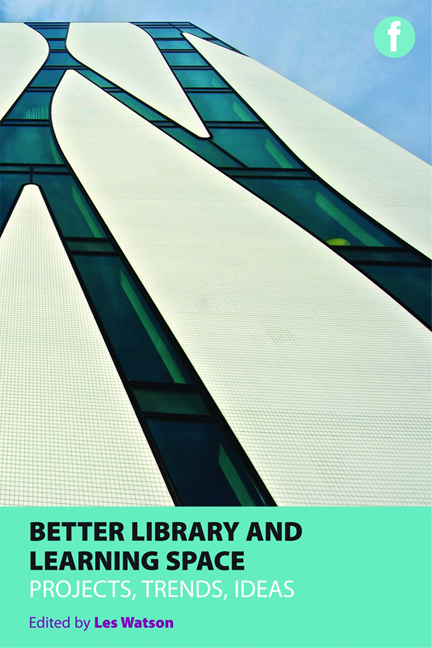Book contents
- Frontmatter
- Contents
- Case studies
- Acknowledgements
- Contributors
- Introduction – about this book
- PART 1 PROJECTS AND TRENDS
- PART 2 TRENDS AND IDEAS
- PART 3 IDEAS AND FUTURES
- Introduction
- 11 Beyond space: access is all – or is it?
- 12 Thinking inside the box
- 13 Nothing has changed/everything has changed – the enduring aspects of learning
- 14 Books, nooks and MOOCs
- 15 The researcher's view: context is critical
- 16 Libraries in the network society: evolution, revolution, extinction?
- 17 Powered by learning: developing models of provision to meet the expectations of new generations of students
- 18 The library has left the building
- 19 Beyond analogue: the learning studio as media-age library
- 20 3D libraries for 3D smarting
- 21 Learning landscapes, the library and the University of Lincoln: efficiency, effectiveness, expression and experimentation
- 22 Viral design: learners building better environments together
- 23 The interior designer's view
- 24 Furniture fit for the future – a brief exploration of library and learning furniture today and for the coming generation
- 25 Conclusions
- Index
14 - Books, nooks and MOOCs
from PART 3 - IDEAS AND FUTURES
Published online by Cambridge University Press: 08 June 2018
- Frontmatter
- Contents
- Case studies
- Acknowledgements
- Contributors
- Introduction – about this book
- PART 1 PROJECTS AND TRENDS
- PART 2 TRENDS AND IDEAS
- PART 3 IDEAS AND FUTURES
- Introduction
- 11 Beyond space: access is all – or is it?
- 12 Thinking inside the box
- 13 Nothing has changed/everything has changed – the enduring aspects of learning
- 14 Books, nooks and MOOCs
- 15 The researcher's view: context is critical
- 16 Libraries in the network society: evolution, revolution, extinction?
- 17 Powered by learning: developing models of provision to meet the expectations of new generations of students
- 18 The library has left the building
- 19 Beyond analogue: the learning studio as media-age library
- 20 3D libraries for 3D smarting
- 21 Learning landscapes, the library and the University of Lincoln: efficiency, effectiveness, expression and experimentation
- 22 Viral design: learners building better environments together
- 23 The interior designer's view
- 24 Furniture fit for the future – a brief exploration of library and learning furniture today and for the coming generation
- 25 Conclusions
- Index
Summary
Introduction
Ssssshhhhhh! Don't tell anyone, but the university library is a hip and happening place. Learning actually happens there. Some even still have books in them. Do you need to work in a group? Do you need a quiet place of respite? Do you like studying in proximity to others? Do you need access to a fast computer? The library has become a spectrum of spaces to cater for every imaginable learning modality. Consequently librarians have become curators of learning, anticipating the resources, services and physical settings to support all levels of education and research.
An archaeological dig of the University of Alexandria dating to the 5th century revealed the instantly recognizable remnants of a series of lecture halls: tiered seating and a podium for the scholar (Majcherek, 2008). Some 1500 years later lectures remain the dominant mode of content delivery across the majority of universities, despite criticisms in recent decades regarding the effectiveness of learning in lectures (Bligh, 1972; Penner, 1984; Hodgson, 1997). In stark contrast, the university library represents a space typology that has adapted to new pedagogies and technologies emergent in the last 20 years, generating a distinctly different student experience from libraries of past eras (Jamieson, 2005).
21st-century library space – it's all about value
Where traditional libraries were typically centred on books and study carrels, the 21st-century library is developing as a dichotomy of spaces: quiet versus noisy (individual and group learning); hi-tech versus low-tech (digital and analogue activities); light versus dark (reading and multimedia activities); open versus closed (short and long duration). Furthermore, the role of books in the student learning experience is being seriously questioned, with librarians being forced to negotiate the value proposition of space for books. Do students get more value from space comprising book collections or places where they can access digital resources and study collaboratively?
In a recent focus group of first-year students discussing use of their university library, the students conveyed their systematic avoidance of sourcing books on course reading lists, in deference to digital resources they found much easier to source (Woods Bagot, 2012). A related survey of students at the same Australian university revealed that access to computers and quiet study spaces were valued above access to book collections, closely followed by demand for group study spaces (Woods Bagot, 2013).
- Type
- Chapter
- Information
- Better Library and Learning SpaceProjects, trends and ideas, pp. 175 - 182Publisher: FacetPrint publication year: 2013

